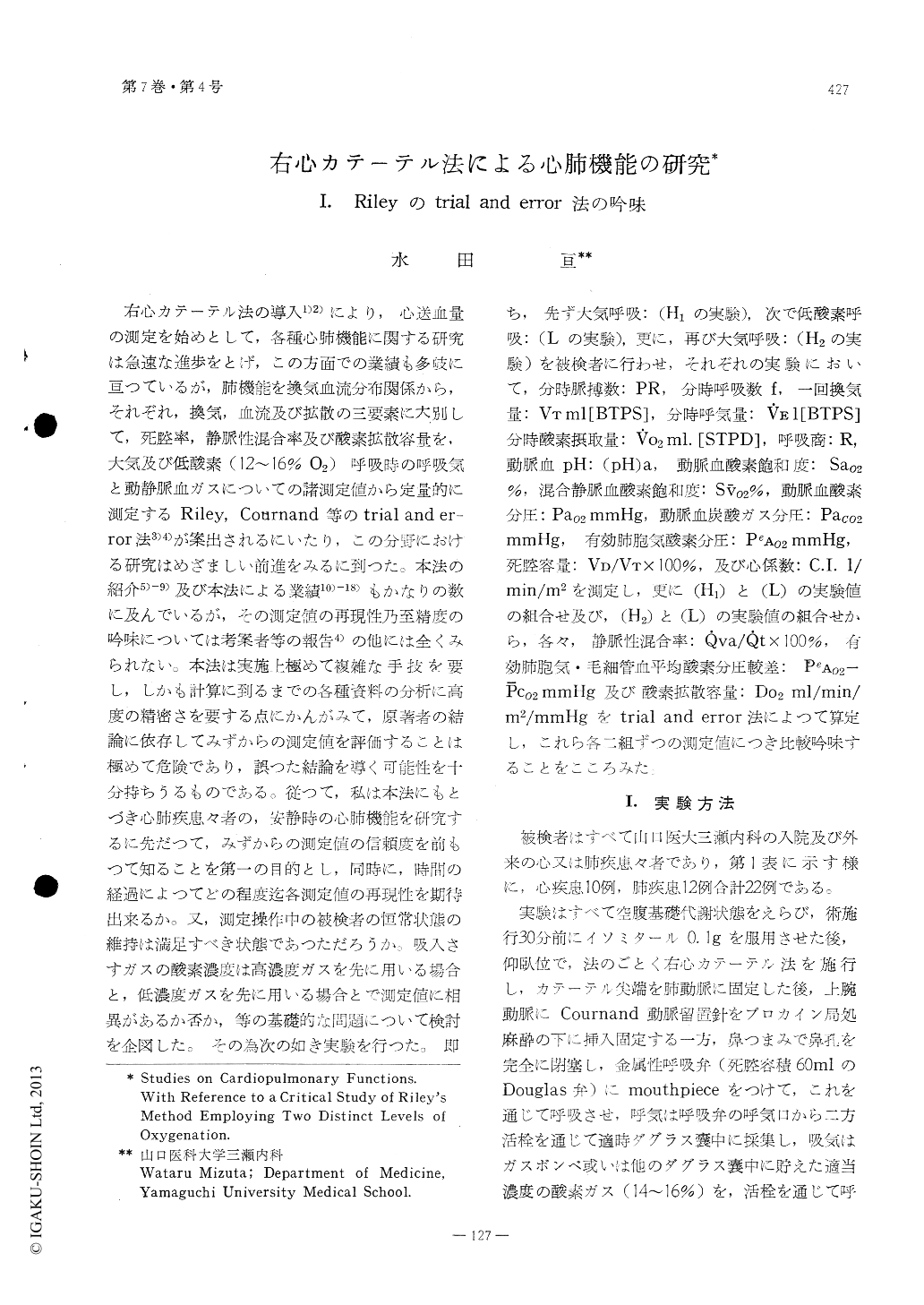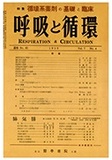Japanese
English
- 有料閲覧
- Abstract 文献概要
- 1ページ目 Look Inside
右心カテーテル法の導入1)2)により,心送血量の測定を始めとして,各種心肺機能に関する研究は急速な進歩をとげ,この方面での業績も多岐に亘つているが,肺機能を換気血流分布関係から,それぞれ,換気,血流及び拡散の三要素に大別して,死腔率,静脈性混合率及び酸素拡散容量を,大気及び低酸素(12〜16%O2)呼吸時の呼吸気と動静脈血ガスについての諸測定値から定量的に測定するRiley, Cournand等のtrial and er—ror法3)4)が案出されるにいたり,この分野における研究はめざましい前進をみるに到つた。本法の紹介5)−9)及び本法による業績10)−18)もかなりの数に及んでいるが,その測定値の再現性乃至精度の吟味については考案者等の報告4)の他には全くみられない。本法は実施上極めて複雑な手技を要し,しかも計算に到るまでの各種資料の分析に高度の精密さを要する点にかんがみて,原著者の結論に依存してみずからの測定値を評価することは極めて危険であり,誤つた結論を導く可能性を十分持ちうるものである。従つて,私は本法にもとづき心肺疾患々者の,安静時の心肺機能を研究するに先だつて,みずからの測定値の信頼度を前もつて知ることを第一の目的とし,同時に,時間の経過によつてどの程度迄各測定値の再現性を期待出来るか。又,測定操作中の被検者の恒常状態の維持は満足すべき状態であつただろうか。
Because of the technical difficulties of Riley's trial and error method, the reliability and accuracy of this method was examined.
On twenty-two patients having cardiopulmonary disease the following three studies were made, successively, under the post absorbtive steady state.
(1) high level of oxygenation (air breathing)
(2) low level of oxygenation (14 - 16% O2 breathing)
(3) high level of oxygenation (air breathing)
The puls rate, respiratory rate, tidal volume, expired air volume; pH, oxygen tension, oxygen saturation and carbon dioxide concentration of arterial blood, oxygen saturation and carbon dioxide concentration of mixed venous blood; effective alveolar oxygen tension, percent dead space and car-diac index were determined in every case.
From the combination of (1) and (2), and, of (2) and (3) ; a pair of percentage venous admix-tures, mean alveolo-capillary oxygen tension gradients and diffusion coefficients were calculated. The following conclusions were reached:
(1) This method was relatively reproducible and reliable provided that the patients were under the steady state during the studies.
(2) The percent venous admixture seemed to be affected by the arterial blood oxygen tension and RQ during the high level of oxygenation.
No specific factors which affected the mean alveolo-capillary oxygen tension gradient and the di-ffusion coefficient could be found. However, it appeared most necessary to maintain the steady state throughout the examination in order to obtain reliable results.
(3) The standard errors were found to be as follows:
Percent venous admixture: ±3%
Mean alveolo-capillary oxygen tension gradient: ±2mm. Hg
Diffusion coefficient: ±2ml./min/m2/mm. Hg
(4) No significant differences could be found between the duplicate determinations of the three components; percent venous admixture, mean alveolo-capillary oxygen tension gradient and diffusion coefficient. Therefore, we should be able to begin the breathing either with high oxygen or low oxy-gen when employing Riley's two distinct levels of oxygenation method.
(5) Under the high level of oxygenation and steady state during one and a half hour to two hours, no statistical differences were found in the puls rate, respiratory rate, tidal volume, expired air volume ; pH, oxygen saturation, oxygen tension and carbon dioxide tension of arterial blood, mixed venous blood oxygen saturation, effective alveolar oxygen tension, percent dead space and cardiac index.

Copyright © 1959, Igaku-Shoin Ltd. All rights reserved.


